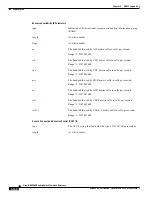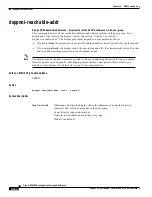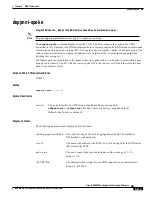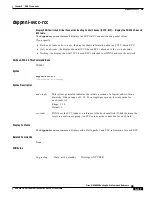
5-105
Cisco MGX 8850 Routing Switch Command Reference
Release 2.0, Part Number 78-10467-04 Rev C0, October 2001
Chapter 5
PNNI Commands
dsppnni-reachable-addr
Display Contents for dsppnni-reachable-addr
The table contains all reachable addresses within a peer group comes from the internal data base (IDB).
Related Commands
dsppnni-link
Attributes
scope
Note
The UNI 4.0 address scope. Refer to ATM forum documentation for
a description of these scopes. The current release does not support
UNI 4.0, so scope currently is always ‘0’.
Range
port id
The logical port identifier.
Exterior
The flag that indicates whether the node is an interior or exterior node.
true: the node is an exterior node.
false: the node is an interior node.
ATM addr prefix
The PNNI summary address assigned to the node.
node name
The name of the switch results from the cnfname command and appears in the
CLI prompt.
Advertising node
number
The number of the remote node that has advertised information to the current
node. This number has a range of 1–256 and appears only if you specified the
network argument.
The local node generates the node numbers in the sequence that it discovers its
neighbors. You can only provide it as a command parameter or view it in
applicable displays. (Note that this node index or node number is not the node
index that identifies a node within the hierarchy of a multiple-peer group. See
dsppnni-node for details on the local node index.)
Transit Network ID
The transit network ID identifies a network where connections from the current
node do not terminate.This number applies to static addresses only. The
application of this option depends on the design intent of the user. The ID can
have up to four IA5 characters (IA5 is a superset of the ASCII character set).
Log: nolog
State: active, standby
Privilege: ANYUSER
















































